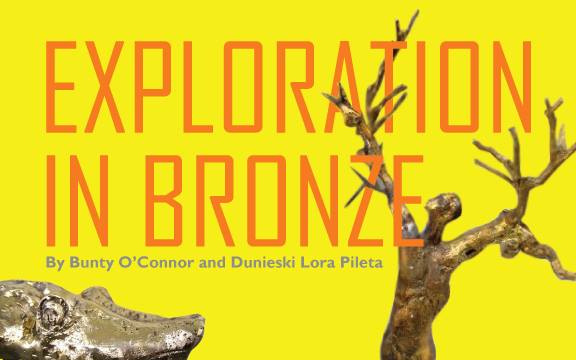
MEDULLA is pleased to invite you to “EXPLORATIONS IN BRONZE” BY Bunty O’Connor (Trinidad) and Dunieski Lora Pileta (Cuba)
OPENING RECEPTION:
Monday 8th September 2014
7:00 p.m. to 9:30p.m.
#37 Fitt Street, Woodbrook, Port-of-Spain
RSVP: 740 7597 / medullaartgallery@gmail.com
EXHIBITION CLOSES: Saturday 13th September 2014
EXPLORATIONS IN BRONZE
Bunty O’Connor from Trinidad joins Dunieski Lora Pileta from Cuba to present recent works in clay and bronze.
Bunty O’Connor is the master potter of Ajoupa Potteries. Dunieski Lora Pileta, “the Cuban” is an accomplished artist who has been working in Luise Kimme’s castle in Tobago. Their show is about transformations.
In Bunty’s case, she is making the leap from clay that is moulded with her strong hands, to molten metal and the “lost wax” method that would fry human flesh. The process is awesome and intimidating, requires two strong men, Rory O’Connor and Dunieski, a fiery kiln, and muscle to finish the statues which will last for all time. She presents both recent ceramic sculptures and some bronzes for this show.
Dunieski’s bronzes are immutable as well. But his starting point is often an organic found object. A piece of driftwood picked up on Mt. Irvine beach seems to have eye sockets. This clump of bamboo root turns a hip bone, with one leg descending. He sees the human form in a branch. He adds dancing arms and elongated fingers.
The idea of working together appealed to Bunty. She grasped the opportunity to learn a new technique in making art. Her account of the collaboration is presented here.
BUNTY WRITES ABOUT BRONZE CASTING
When I think of bronze casting, the whole industrial revolution comes to mind, the diabolical genius of mankind and his roaring furnaces, machinery and transport that changed the face of civilization. “Coalbrookdale by night” by Phillipe Jacques de Loutherbourg, painted in 1801, shows a small town lit up by unearthly light, where the fires of the forges burned day and night. The process of casting metal fascinates and repels me at the same time. It is devilishly complicated, requiring skillful mastery of tools, materials and fire at every step of the process.
In her last years, Luise Kimme spoke often with Rory and me about bringing “the Cuban” to Trinidad to teach the art of bronze casting. A firm date always eluded us. But when she became ill in 2012 and could not make her planned trip to Cuba, Dunieski Lora Pileta came to Tobago to help care for her.
Dunieski is an artist/craftsman who is accustomed to working with all kinds of materials. He lived in Santiago de Cuba all his life; graduating from high school and Universidad de Oriente in Santiago, in art: two dimensional forms such as lithography and painting as well as the plastic arts, ceramics, sculpture and metal casting. Living in Cuba where materials and tools are scarce, he had to make art with whatever he could find. He created a workshop on a plot of land given to him by the Taller Cultural; he would teach and others could practise.
Luise met Dunieski at the Taller Cultural, where she made small sculptures which would be bronzes. “He is fantastic!” she wrote. She showed her drawings to him, he made metal armature for the clay and she made her sculpture. From these sculptures, Dunieski made the bronzes.
Bronze melts at a temperature of about 900 degrees C. As it gets hotter it burns with a luminous green flame. Hard metal chunks gradually melt in the crucible until they are able to flow like lava, giving off a tremendous bright light and an enormous amount of heat.
Plaster moulds are made from sculptures that are to be arrested in the metal. Into these moulds, hot wax is painted until a thin layer is built up to create a thin walled, fragile replica of the original sculpture. This wax replica must now be cast inside and out with a mixture of plaster and refractory mortar and fired in the kiln. As this mould gets hot, the wax begins to melt away, leaving a cavity for the bronze to enter – hence the name – lost wax.
At a precise moment, the hot moulds are taken out of the kiln and secured in holes in the sandy floor, their open ends ready to receive the bronze. Rory and Dunieski pour the molten bronze, glowing orange, into the moulds. Gradually the metal cools and the bright orange lava-like quality of the bronze fades to a dull metallic sheen.
The physical process of casting alarms me. I feel that my carefully modeled ceramic sculpture doesn’t really transfer to hard metal. I want to make something more sinuous or serpentine that can take on the flowing quality of the molten bronze.
Dunieski doesn’t torment himself with these agonies. He makes his sculptures with long pieces of bamboo root, natty coconut fibers, beach detritus and plaster, modeling these with found objects and toys. In Cuba everything is used, nothing is wasted. Sharing and working together are a way of life. His culture is the very opposite of ours where we accumulate and discard almost in the same measure. I like the idea of recycling. I also like the danger of not knowing what will happen to my carefully made object. Even though it breaks I can resuscitate it in wax and change it or improve it.
It has been a voyage of discovery with good companions. We hope you like the objects we have founded.
Please note, that there will be two exhibitions running concurrently at Medulla between Monday 8th and Saturday 13th September 2014. One on the upper floor and one in the main exhibition area.



recent articles
A CONVERSATION ART
Light movements.
FILM
ttff/ 2021 is here and watch meh!